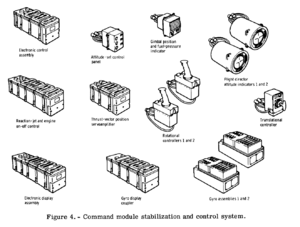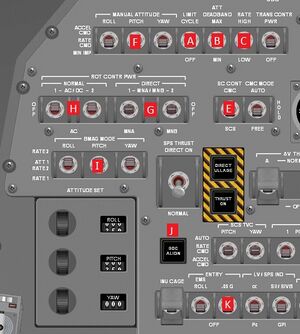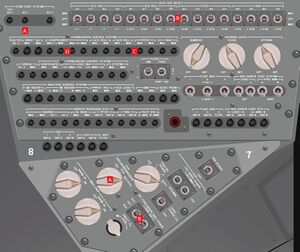Stabilization and Control System
The Stabilization and Control System (SCS) provides a capability for monitoring and controlling the attitude of the spacecraft, for translational manoeuvers and SPS thrust vector control. Also the SCS is the backup system for the Primary Guidance, Navigation and Control System (PGNCS), which is the Apollo Guidance Computer basically.

SCS Electronics
Gyro Display Coupler
The Gyro Display Coupler, or GDC, serves as a back-up platform of reference to the IMU. The GDC updates its current knowledge of the spacecraft's attitude by adding rate data from the BMAGs. This is referred to as the GDC's Euler mode. The BMAG which the GDC is receiving data from can be selected with the three BMAG switched on MDC-1. 1.I The GDC can also be realigned to the IMU by using the ASCP panel and the GDC ALIGN push-button. 1.J This enters the GDC Align mode, until the push button is released. For detailed information on realigning the GDC, see the ASCP section. Finally, placing the EMS .05g switch 1.K in the up position puts the GDC in Entry mode.

Electronics Control Assembly
The Electronics Control Assembly or ECA is the logic center for the SCS system. It contains the electronics used for rate command, attitude hold, and minimum impulse control modes. It also uncages the BMAGs for Gyro Assembly 1, allowing for attitude data to be received by the GDC. Finally, the ECA translates RHC and THC commands into signals for the RJ/EC. Current to the ECA is supplied via the SCS circuit breakers 8.A on MDC-8. The rotary switch on MDC-7 7.A activates the ECA.
Reaction Jet and Engine On/Off Control

The Reaction Jet and Engine On-Off Control, or RJ/EC, sends commands to stop and start the 16 service module and 12 command module RCS thrusters. The RJ/EC receives signals from the CMC, when the spacecraft is under computer command, from the ECA, when under SCS command, and from RHC and THC when under direct command. The signals from these inputs are then used to open and close RCS solenoids. These individual solenoids can be enabled and configured through the 16 AUTO RCS switches on MDC-8. 8.B The RCS thrusters can be powered with either Main Bus A or B, or receive no current. The RJ/EC is powered using AC and can be powered with the Sig/Cond Driver Bias switches on MDC-7. 7.B The RCS CMD switch on the lower left of MDC-2 is spring and can be switched down to block RJ/EC command to the automatic coils. Moving the switch to the up position allows RJ/EC command to be received by the RCS again.
Attitude Control
Attitude & Rate Deadbands
To assist in stabilizing the spacecraft, the SCS has both attitude and rate deadbands. These are certain boundaries within which the attitude control subsystem operates. The rate deadband prevents the spacecraft from rotating faster than a given speed, measured in degrees per second, about the roll, pitch, and yaw axis. The attitude deadband steadies the spacecraft to prevent it from drifting more than a few degrees from a target attitude. The limits are configurable through three switches on MDC-1. These are the limit cycle switch 1.A, the rate switch 1.B, and the attitude deadband switch 1.C.
The rate deadband is operational when receiving rate data from the GDC and the rate command manual mode is selected. The RHC normal power switches must be on, and at least one BMAG must be powered to deliver rate data to the GDC. When the rate needles on the FDAI reach the edge of the deadband the spacecraft's rotation will remain constant at that rate. The rate switch sets the size of the deadband.
The attitude deadband works in a similar manner to Orbiter's kill-rot auto pilot. It does not completely null the spacecraft's rates, but instead tries to keep the spacecraft's attitude within a particular boundary, or the attitude deadband. In order to maintain attitude, GDC must be receiving attitude data from BMAG 1, so one or more BMAG switches must be set to ATT1/RATE2 1.I. The spacecraft must also be in rate command mode. This configuration is referred to as attitude hold. When the spacecraft drifts into the attitude deadband, the ECA will command for thrusters to fire in the opposite direction. The radius of the attitude deadband is determined by both the rate and attitude deadband switches. To help conserve fuel, the limit cycle switch can be used. When the limit cycle is set to on, the ECA will command that the RCS thrusters be pulsed as the attitude approaches the deadband. This is referred to as pseudo-rate.
RHC Normal
Under normal RHC configuration, breakout switches in the RHC send commands to the automatic solenoid coils through the ECA and RJ/EC. The RHC normal breakout switches must first be powered. 1.H The RJ/EC sends 28-vdc to the solenoid via either Main Bus A or Main Bus B, depending on the Auto RCS switch settings 8.B. These individual coils are powered by closing the SCS A/C ROLL, B/D ROLL, PITCH, and YAW circuit breakers on MDC-8 8.C. For attitude control to be handled by the SCS, the S/C Control switch must be set to SCS. 1.E This allows for four different modes of SCS control. The manual attitude switches 1.F on MDC-1 determine what mode is being used for each axis: acceleration command, rate command, or minimum impulse. Depending on whether or not BMAG 1 is uncaged 1.I, rate command can either be in proportional rate command mode or attitude hold mode.
Acceleration Command - Under acceleration command, the spacecraft is commanded much like any traditional Orbiter craft. Deflecting the RHC will command rate in that axis. The spacecraft will continue to accelerate until the RHC is centered and then will maintain that rate.
Proportional Rate Command - The RHC's transducer sends signals to ECA that commands rate proportionate to deflection of the RHC. This allows the CSM to be controlled in a manner similar to conventional aircraft. Full RHC deflection produces a maximum rate determined by the rate switch on MDC-1. Under rate low, full stick deflection commands a rate of 0.7 deg/sec in any axis. Rate high will allow for up to 7 deg/sec in the pitch and yaw axis and 20 deg/sec in the roll axis. When the RHC is centered, the SCS enters rate damping mode, which null the commanded rates.
Attitude Hold - If the ECA is receiving attitude data in an axis from a BMAG (meaning the BMAG switch is set to att1/rate2), the ECA attempts to hold that attitude in that axis. Attitude hold mode is similar to Orbiter's kill-rot, except that it only holds the spacecraft within a certain distance from the target attitude. This distance is determined by both the rate and attitude deadband switches described in the previous section. Attitude hold will not null rates, but the SCS will prevent the CSM from drifting.
Minimum Impulse - A single thruster is fired when commanded by the RHC. Minimum impulse uses the ECA's one-shot logic for a 15 millisecond burst from a single quad. To be fired again, the RHC must be first re-centered. This provides ability for fine attitude control. However, without a second thruster to counteract the movement, minimum impulse introduces translational thrust that must be corrected for during MCCs.
RHC Direct
Direct switches close when RHC is deflected 11+ degrees. These open and close RCS direct solenoids and provide acceleration only commands. Ullage before SPS burns, S-IVB superation ullage, and the post SM/CM sep maneuver also use direct RCS. The direct RCS coils are supplied with power through the circuit breakers on MDC-8 8.D, and the direct switches in the RHC are powered by switches on MDC-1 1.G. RHC direct does not require any interface with the ECA and can be used if normal RCS modes are not operational. To prevent the ECA from issuing command during delta-V maneuvers, this is the only operational mode of the RCS during SPS burns.
External Links
- Apollo Operations Handbook: Stabilization and Control System
- Apollo Experience Report: CSM Stabilization and Control System
